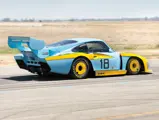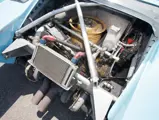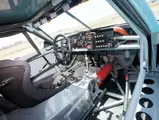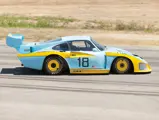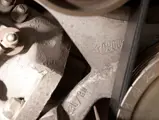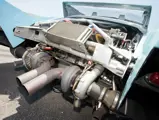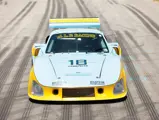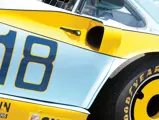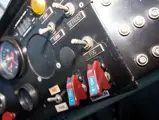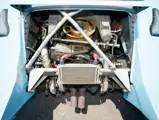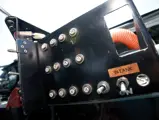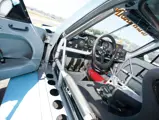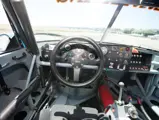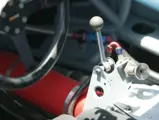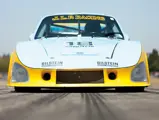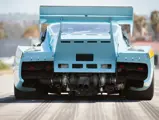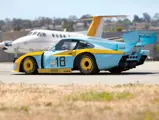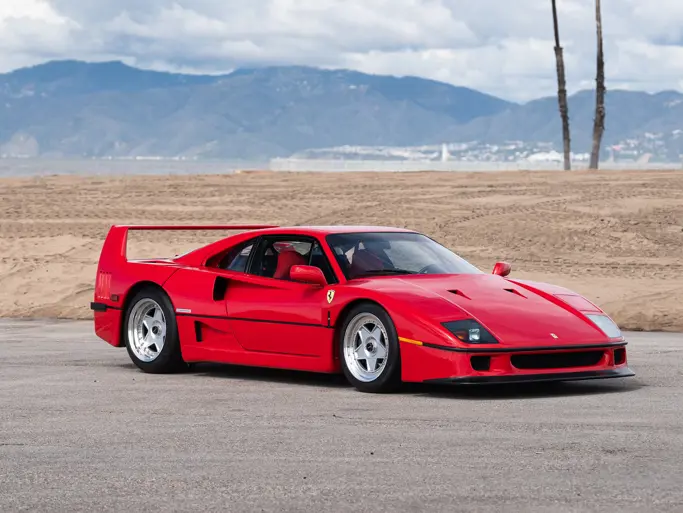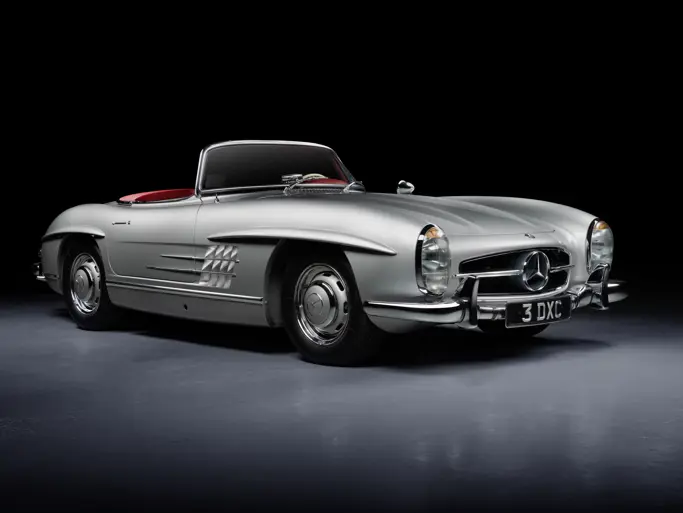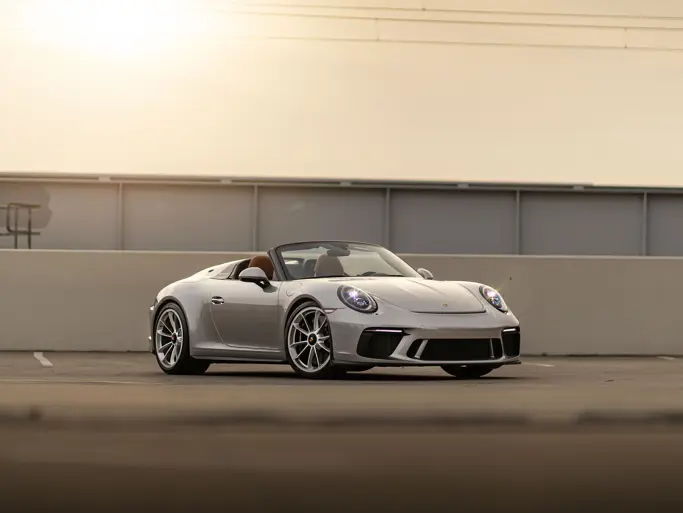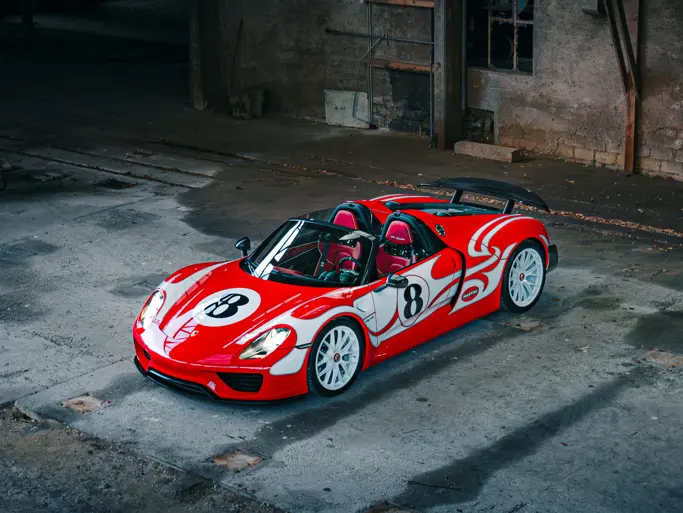Monterey 2012
1981 Porsche 935 JLP-3 IMSA Racing Car
{{lr.item.text}}
$1,300,000 - $1,800,000 USD | Not Sold
 | Monterey, California
| Monterey, California
{{internetCurrentBid}}
{{internetTimeLeft}}

750+ horsepower, 3.2-liter twin turbocharged flat six-cylinder engine, four-speed transaxle, four-wheel independent suspension with coil springs and tubular shock absorbers, and four-wheel disc brakes.
Please note that this vehicle will be offered on a Bill of Sale of only.
• Ex-John Paul Sr. & Jr. and Derek Bell
• The only car to win both the Daytona 24 Hours and the Sebring 12 Hours in the same year
• 1982 IMSA Camel GT Championship winner
• Five consecutive race winnings and 16 podium finishes in 26 races
• Professionally restored by Gunnar Racing, with maintenance by Gunnar and Canepa Design
The saga of the Porsche 935 started out innocently enough as Porsche adapted its 930 Turbo road car to racing. Turbocharging had already conclusively demonstrated its value to Porsche on the all-conquering 917 sports racing cars, but the 935 and its variants would take the concept to a whole new level. The 930 Turbo Porsche was introduced at the September 1973 Frankfurt Motor Show and the Turbo Carrera Group 4 competition car followed.
The Turbo Carrera was based on the 930/911 body structure and suspension, a production-based GT developed within the FIA Group 4 rules package. The engine displaced 2,142 cc, exactly equaling the three-liter displacement limit when the 1.4X supercharging factor was applied, and utilized a standard two-liter Porsche 911 crankshaft. In common with all Porsche competition engines to that point, the Turbo Carrera used dual ignition, and the standard Bosch mechanical injection system was modified to take positive induction pressure into account. Fitted with other refinements and developments from years of competition experience, the Turbo Carrera engine delivered 500 brake horsepower and 340 lb/ft torque. The latter was more than the naturally aspirated 4.5-liter flat-twelve engines that powered the Porsche 917 just five years before!
Group 5 and the 935
The FIA turned its displeasure on sports prototypes, starting with the 1976 season, creating Group 4 for production-based GT cars and a new Group 5 for “silhouette” race cars based upon production models that qualified for the FIA’s Groups 1 through 4. In the process, the FIA decreed that it was from among the Group 5 competitors that the World Champion of Makes would be won.
Porsche’s answer to the Group 5 challenge was the 935. It evolved steadily over the coming seasons, winning all the major endurance races from Le Mans and the Nürburgring to Daytona, Sebring, and Watkins Glen, capturing the coveted World Championship of Makes. Its engine evolved separately to power the 936 prototypes and eventually the 956 and 962 sports prototypes that firmly cemented Porsche’s reputation as the pre-eminent builder of competition GT and sports prototype racing cars.
Eventually the 935 evolved into a full tube-frame racing car design that shared only the mandated elements with the Porsche 911 and 930 production cars. Specific variants were adapted to specific races and circuits. The most famous of these were known as “Moby Dick,” the long tail, low frontal area 935/78s built by Porsche specifically for Le Mans, but which the public took to calling all the high performance 935s. As with Moby Dick’s aerodynamics, there was nothing moderate about the many 935s. They employed the latest design developments and took the regulations to the absolute limits of their interpretation. The 935s challenged Porsche’s creativity, as in the decision to adopt 19-inch rear wheels, which, within the rules’ limit of a 16-inch maximum tire width, lengthened the tires’ contact patch and provided a contact patch equivalent to much wider tires of smaller diameter.
The 935 engines were similarly developed for specific rules packages. The FIA, CSI, SCCA, and IMSA did not make the process easy, changing their minds and going in different directions over the years. Single turbo, twin-turbo, air-cooled, oil-cooled, water-cooled, single ignition, dual ignition, air-air intercooled, air-water intercooled, two-valve, four-valve, three-liter, two-liter, 3.2-liter, and 2.2-liter engines in various combinations all appeared under the 935’s engine cover and all successfully raced. At various points in its history, variants of the Porsche 935 flat-six produced in excess of 800 brake horsepower, putting the production-based engine’s power output well within the range of the full competition flat-12 Porsche 917 of only a few years earlier.
As Porsche’s emphasis shifted in subsequent years to design and development of the 956 and 962 sports prototypes, entrants began to build their own Porsche 935s using some elements of the factory designs and the mandated production-based components: engine, gearbox, windshield, roof, and door frames. The most famous were the racing Kremer brothers, closely matched by Reinhold Jöst. In the U.S., IMSA competitors like Bob Akin and Dick Barbour turned to local builders for their own Porsche 935s.
JLP-3
The father and son driving team of John L. Paul Sr. and Jr. turned to Graham “Rabbit” Bartrills’ GAACO company in Norcross, Georgia to build a special Porsche 935 for endurance races. Given the designation JLP-3, aside from the engine and transmission, it used only the cowl, windshield pillars, roof, and door frames from a Porsche (a 1972 911T). The rest was all high-tech, tube frame, custom fabricated race car with lightweight fiberglass bodywork and the latest suspension and aerodynamics. For sprint races, the Paul’s commissioned another car, JLP-4, designed by Lee Dykstra and built by Dave Klym’s Fabcar.
JLP-3 is the car offered here. It is believed to be the most successful of all Porsche 935 race cars. It is the only car to ever win both the Daytona 24 Hours and the Sebring 12 Hours in the same year, 1982. It recorded an unprecedented, seven consecutive First Place finishes from Pocono in September of 1981 through Charlotte in May of 1982. In its career of exactly two years from Sebring 1981 through Daytona 1983, out of a total of twenty-seven races, it recorded nine wins and sixteen podium finishes. That’s a win in every three races entered and a podium in 60% of its races, an astonishing achievement.
In addition to the Pauls, it was driven by Derek Bell, Mauricio de Narvaez, and Rolf Stommelen. Its finishes contributed to John Paul Jr.’s 1982 Camel GT Championship and his father’s 1982 international Triple Crown of Endurance Championship.
Powered by an air-cooled, 3.2-liter IMSA-spec engine with Bosch mechanical fuel injection, the twin-turbo Porsche 935 JLP-3 was restored some years ago by the Porsche specialists at Gunnar Racing and has been maintained by them, and by Canepa Design, since. Presently in the hands of only its fourth owner since the John Pauls, the JLP-3 has recently undergone a painstaking race preparation, at which time its twin-turbo, air-cooled, 3.2-liter motor, four-speed transaxle, suspension, and brakes were all rebuilt. JLP-3 is currently race ready and more than capable of winning at an international historic level. It is eligible for all foreign and domestic IMSA GT vintage events, including selected events such as the Monterey Historics and the Wine Country Classic.
All of that is significant, but what is really important is that this is, in the opinions of expert aficionados, the definitive Porsche 935. The GAACO chassis, carefully laid out to maximize responsiveness, handling and, most importantly, balance, is, in the words of a skilled 935 vintage racer who has driven JLP-3, “well balanced and easy to throw around, not like most 935s. It is fast, fast, fast. If I got someone on the track in my sights, I knew I could pass them. It is an experience to drive, is eligible for everything, and has the potential to win any historic race it enters.”
On any continent, in any company, JLP-3 is a welcome entrant and a participant that will thrill its drivers and everyone fortunate enough to see it perform. Its record of back-to-back victories in the Daytona 24 Hours and Sebring 12 Hours is unmatched in the fabled history of these two races, and with 23 podium finishes, nine First Place wins, and seven consecutive victories, JLP-3 is considered by many as the most dominant of all Porsche 935s in existence for a reason.
JLP-3 Complete Competition History
1981 IMSA Camel GT Championship
Sebring 12 Hour – John Paul Jr. / John Paul Sr. – DNF
Road Atlanta (1) – John Paul Jr. – 8th
Riverside – John Paul Jr. / John Paul Sr. – 2nd
Laguna Seca – John Paul Jr. – 2nd
Lime Rock – John Paul Jr. – 6th
Mid Ohio – John Paul Jr. – 3rd
Brainerd – John Paul Sr. – 3rd
Daytona (II) – John Paul Jr. / John Paul Sr. – 3rd
Mosport – John Paul Jr. / John Paul Sr. – DNF
Road America – John Paul Jr. / John Paul Sr. – 13th
Road Atlanta (II) – John Paul Sr. – DNF
Pocono – John Paul Jr. / John Paul Sr. – 1st
Daytona Finale – John Paul Jr. – 1st
1982 IMSA Camel GT Championship
Daytona 24 Hour – John Paul Jr. / John Paul Sr. / Rolf Stommelen – 1st
Sebring 12 Hour – John Paul Jr. / John Paul Sr. – 1st
Road Atlanta (I) – John Paul Jr. – 1st
Riverside – John Paul Jr. / John Paul Sr. – DNF
Charlotte – John Paul Jr. / John Paul Sr. – 1st
Daytona (II) – John Paul Jr. – DNF
Sears Point – John Paul Jr. – 20th
Mosport – John Paul Jr. / John Paul Sr.
Road America – John Paul Jr. / Mauricio de Narvaez – 2nd
Mid-Ohio – John Paul Jr. – 41st
Road Atlanta (II) – John Paul Jr. / John Paul Sr. – 1st
Pocono – John Paul Jr. – 2nd
1983 IMSA Camel GT Championship
Daytona 24 Hour – John Paul Jr. – DNF
* 1982 IMSA Camel GT Championship Winner
* 1982 Daytona 24 Hour Overall Winner
* 1982 Sebring 12 Hour Overall Winner
* Overall Race Wins (Five Consecutive)
* 16 Podium Finishes in Twenty-Six Races


